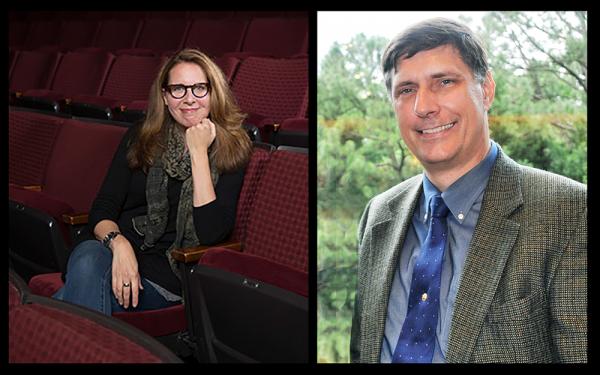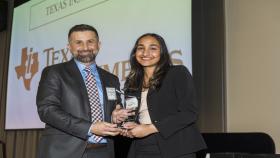Atharva Deshmukh had to share a story in front of his classmates in BMED 4000, ‘The Art of Telling Your Story,’ a required course for undergraduates in the Wallace H. Coulter Department of Biomedical Engineering at Georgia Tech and Emory University (BME). Deshmukh thought about the core values he wanted to convey, resilience and perseverance. Now there was nothing left to do but dive in.
He told the story about the time he almost drowned as a young boy while visiting his grandparents in his native India. “I was four, and I get to the pool, very excited. I’ve got my floaties on and I’m feeling great,” says Deshmukh, a senior. “I’m going back and forth across the pool, feeling like a champion, until …”
Until his instructor took off the floaties and he sank like a rock, 12 feet to the bottom. He doesn’t remember much about being four, but he remembers this clearly. He remembers, “my instructor and my grandfather diving down to get me. Then an irrational fear set in. I didn’t touch the water for years. I hated going to the beach, hated pool parties. I would not go anywhere near the water.”
His story could have ended there, with the fear. But his mother stepped in, buoyed his spirits, enrolled him in a YMCA swimming program. After a few tantrums, Deshmukh says, “I started liking it – loving it, actually. I got into summer swimming league at the neighborhood pool and it evolved from there. The more time and effort I put into it, the better I got. By the time I got to high school I was competing at the state level, something I never thought was possible.”
It felt good to share the story, to openly admit his childhood fear and especially to explain how he not only overcame it, but crushed it. His experience gets to the heart of why BMED 4000 has become a favorite class among BME undergrads.
“We’re all engineers, we all have tough courses, research, internships, a lot of pressure. Then you come into this class for two hours a week, and you’re able to sit down and think and reflect on yourself and what you’ve accomplished, and share, all in a safe place,” says Deshmukh, who took the class last year, when it was still, more or less, an elective, and taught in-person, before the pandemic.
Shae Padiyar, who took course in fall 2020, says the online version of BMED 4000, “is really a breath of fresh air. And even though the class is virtual, you really get to know your classmates. You really create some special bonds. Our cameras are always on, so you can’t hide. You have to make connections.”
The Three C’s
As if on cue, Padiyar has referred to one of the three C’s considered to be the key elements in the ‘entrepreneurial mindset,’ as defined by the Kern Family Foundation, which vigorously supports an entrepreneurial—or intrapreneurial—focus in engineering education. Georgia Tech became part of the Kern Entrepreneurial Engineering Network (KEEN) two years ago, winning a $1.5 million KEEN Award to create a new way of fostering the entrepreneurial mindset in BME undergrads.
The three C’s are curiosity, connections, and creating value. The entrepreneurial mindset requires: curiosity about the world; connecting information from multiple sources to gain insights and manage risk; creating value for others.
Joe Le Doux, BME’s executive director of training and learning, has been the driving force behind what he calls, “story-based learning.” Le Doux made the connection with KEEN while attending the 2015 meeting of the Biomedical Engineering Society in Tampa, where he ran into Doug Melton, KEEN program director, who was intrigued by Le Doux’s message about mentoring ‘intrapreneurs’ at Georgia Tech.
“An intrapreneur is someone who behaves like an entrepreneur within a larger organization, integrating risk-taking and innovation to solve problems,” Le Doux explains. “As it turned out, our goals at BME aligned with KEEN’s.”
And now, the foundation that is funding BME is using the same method in their training—KEEN takes a story-driven learning approach for one of its leadership programs. Also, other departments at Georgia Tech want in. The Daniel Guggenheim School of Aerospace Engineering and the School of Civil and Environmental Engineering, along with Create-X (Georgia Tech’s student entrepreneurship program), are joining the Coulter Department in going after a second Kern Family Foundation grant. The concept has caught on at other institutions, too. James Madison University and Rochester Institute of Technology are joining with Georgia Tech in offering story-driven learning programs, thanks to seed grants from KEEN.
“I’m actually blown away by the enthusiasm,” Le Doux says. “When we got this course approved in the department, there wasn’t a single no vote.”
In the BME course catalog, BMED 4000’s description reads, “Students will create a professional portfolio and develop the ability to pitch themselves to an audience to prepare themselves to begin their professional careers.”
And that’s all true. The students develop a portfolio, a collection of stories and experiences posted online with a personal biography, and visual elements and artifacts, such as images of report cards side by side to to illustrate how poor grades during freshman year became good grades by the end of sophomore year, “to demonstrate that freshman year didn’t define me, for example,” Deshmukh says. “There’s value in how you share your story with others, value in sharing your skills, experiences, and accomplishments.”
To help guide BME students through the process – because we are not always the most reliable narrators of our own stories, thanks to ‘imposter syndrome’ – Le Doux and his colleagues have brought in an acknowledged expert in the art of making story, award-winning Atlanta playwright/screenwriter Janece Shaffer.
Creating Impact
Shaffer has written character-driven plays that embrace a wide range of topics, which have been produced all over the country. She’s written and produced screenplays, has spent 20 years writing, editing, and marketing stories in different settings, for different organizations. All of this experience led to the 2016 launch of her company, StoryReady, the vehicle through which Shaffer collaborates with and guides companies and individuals to create impactful stories for personal and professional success.
Part of her job as the BMED 4000 instructor has been inspiring her students to overcome imposter syndrome – irrational feelings of inadequacy and self-doubt and intellectual fraudulence that persist despite evident success.
“This is one of the best BME departments in the country, so the students are hyper aware that they’ve made it into the room,” Shaffer says. “So it’s easy to feel like, ‘did I sneak in when no one noticed?’ But I know how hard they’ve worked just to earn their spot in this room. I know how high their expectations are, how badly they want to succeed. So my motivation is to create a place where they can breathe easy and feel part of a community.”
These are students who have been competing for most of their lives – competing with other students to be accepted into the best schools, the best programs. These are driven young people who nonetheless may struggle with self-doubt in the face of so much do-or-die competition, and risk. Adopting an entrepreneurial mindset requires some risk, though, and sharing personal stories can be a great training ground, because it is risky business, opening up the storyteller to all manner of feedback and external conclusions.
“But we don’t promote the idea of competing against each other in this course,” Shaffer says. “We can all struggle with the inner critic that holds onto everything we’ve done that’s been less than perfect. But the idea of being perfect is a down payment on being really disappointed. What we often think of as ‘failure’ is an accepted part of taking risks. As soon as we let go of the idea of being perfect, we can enjoy the process and celebrate the progress. And that’s when you see them exhale, and once they exhale, they are comfortable with taking risk.”
Shaffer is BMED 4000’s ringer, an experienced dramatist who can discuss with her students the deeper relevance of their stories, helping them connect the dots, “so that they see themselves in the best light, and develop a level of clarity and confidence so when somebody says, ‘hey, Atharva, tell us your story,’ you’re ready with with a response because you’ve spent time thinking about who you are and what you value and what you hope for yourself.”
In Atharva Deshmukh’s case, Shaffer notes, he could have ended his story with the struggle of nearly drowning, “but he was encouraged to explore and make larger connections,” she says. For instance, he became a swimming coach, inspiring athletes in the U.S. and abroad, and what began as a story of helplessness and fear became a narrative that illustrates the young man’s grit.
“Now when he meets an obstacle, he can apply that deep knowing and confidence to take on bigger challenges, make more impactful connections, and create even greater value,” Shaffer says.
From the start, Shaffer was amused by the idea of left brain vs. right brain, “that engineers are supposed to be left-brained linear thinkers. That’s a misconception, because they need all of that right-brained creativity. We want to hold tight to those creative impulses. They’re going to allow you to hear the needs of the population you’re serving, and achieve a level of empathy that will allow you to create and design more effectively.”
Changing the Room
In the wake of a global pandemic, Shaffer and her BMED 4000 colleagues have had to change the classroom and, to a degree, how the class is taught. Shaffer can’t make the class get up and explore the classroom space together any more, for one thing. Instead, she might ask them to explore the space in their own places, or send them on scavenger hunts to gather items that would help illuminate a story.
But since she took on the assignment at Georgia Tech, Shaffer always has been encouraged by what she calls, “the creativity in this room.” Her students are all focused engineers, schooled in numbers and the application of them. But they also are musicians, dancers, and at least one published poet – Brady Bove, a fifth year senior (now a teaching assistant for BMED 4000) who took the earliest incarnation of the course, recently published a book of her poetry, A Day of Humanity.
“I’ve always been a writer, but this course really did help me find my voice,” says Bove, whose book of story poems are based on personal reflection, and what she learned from her classmates.
Now that the class is being taught entirely online, and she is a T.A., Bove worried about losing the intimacy of the course that she so enjoyed. “But the students are taking their physical distance and striding right over that,” she says. “They are so open with their stories – everyone is heard. It’s been cool to see this evolution take place, to do the virtual breakout rooms, to meet one on one online, to see the positives and negatives of a virtual class as it develops.”
One assignment this year that struck a chord with her was based on the Humans of New York book and blog, in which students interviewed another classmate, then wrote about that person in the first-person, an empathy-building exercise that resonated with Bove, who says, “all of the poems in my book are different stories, told by someone who trusted me. It’s one thing to tell your own story, quite another to tell someone else’s, when trust is given. This course really helped me with that.”
Le Doux and his team have designed a course that promotes a student’s entrepreneurial mindset, “helping them see that they’re people who are curious, who make connections, and who create value,” Le Doux says. That is the intention. But there also are happy side effects – the ability to convey information effectively (good storytelling) can give a student a leg up when the time comes to apply for a job, or pitch an idea.
“I know the BME curriculum has helped prepare me to go into industry, but one thing that sets Georgia Tech engineers apart is an emphasis not just on hard skills – being able to do math or science,” Bove says. “But it’s also important to know how to work on teams, how to communicate effectively, how to tell not only your story, but to share information that might be very dry or difficult to understand. It’s an important balance.”
And some stories live beyond the telling. That’s the value added. That’s what Shae Padiyar discovered this fall when she was asked to tell a story that described a leadership moment. It happened just as Covid-19 was forcing students to stay home last spring, when Padiyar, who is president of the BME Student Advisory Board, got a call from an international student who had no place to go. Because some of her family is immunocompromised, Padiyar felt helpless. She couldn’t do anything personally to help her friend. Her story was about the moment when she realized she realized that she had no control.
“I was very upset, feeling privileged to have a house, a place to stay, when others didn’t have that luxury,” says Padiyar, whose family lives in Cumming, about 45 minutes north of Atlanta. “I went to a playground in my neighborhood and it brought me back to being a child, when playgrounds were my safe place, my happy place. It made me realize that all students deserve a safe place, they shouldn’t be left with no place to go. That prompted me to start the Jacket Shelter Initiative.”
Still a work in progress, Padiyar has recruited fellow students who are working now to make the initiative become a real thing: a temporary living space for students. The response from her BMED 4000 classmates, to her story and the idea that sprang from it, was remarkable, she says. “Not only was I encouraged as a storyteller, but a lot of my classmates want to be part of the initiative. The power of this class is, it teaches students how to advocate for themselves, for their ideas, whether you’re communicating with a prospective employer, or in a competition, or on someone else’s behalf. It has not only rounded out my undergraduate education – I feel like it is the best class I’ve ever taken.”
Atharva Deshmukh brings it back to one of the all-important C-words – connection, but not so much about connecting concepts, but connecting human beings, and learning to do so in a safe space makes all the difference.
“It really feels like students were sharing things they wouldn’t share anywhere else,” he says. “Showing their vulnerability. That’s where this class sets itself apart from others. There were a few times when I got emotional. Not because of what I shared, but because of something that someone else shared. Inciting emotion in someone else, and forming that connection – that’s the art of storytelling.”
Media Contact
Keywords
Latest BME News
Jo honored for his impact on science and mentorship
The department rises to the top in biomedical engineering programs for undergraduate education.
Commercialization program in Coulter BME announces project teams who will receive support to get their research to market.
Courses in the Wallace H. Coulter Department of Biomedical Engineering are being reformatted to incorporate AI and machine learning so students are prepared for a data-driven biotech sector.
Influenced by her mother's journey in engineering, Sriya Surapaneni hopes to inspire other young women in the field.
Coulter BME Professor Earns Tenure, Eyes Future of Innovation in Health and Medicine
The grant will fund the development of cutting-edge technology that could detect colorectal cancer through a simple breath test
The surgical support device landed Coulter BME its 4th consecutive win for the College of Engineering competition.









